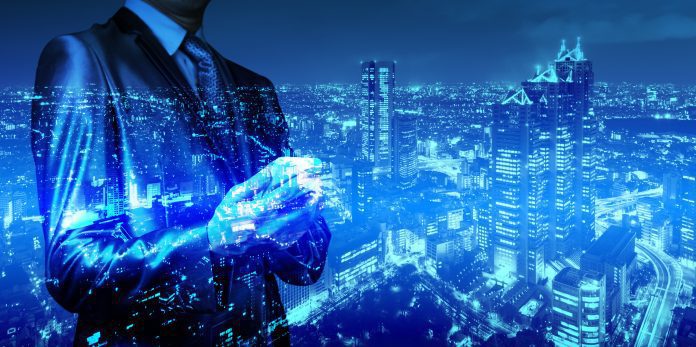Today, many new startups are leveraging the proliferation of the internet of things, machine learning and energy savings solutions to bring about massive innovation to the smart building arena. Here?s a list of the ten companies that are developing technologies capable of reshaping the future of smart buildings.
1. VG Smartglass is a Chicago-based company that has developed a revolutionary breakthrough in dynamic glazing for windows installed in commercial offices and high-rise residential buildings. A user can make any window to go from bright to dark and dynamically adjust for privacy, glare, and energy control. Current ?smart glass? alternatives are expensive and depend on electricity or phase changing materials. The VG technology is user controlled, requires no power or phase changing materials, and is a lower cost alternative to smart glass.
2. Sagegreenlife designs,?manufactures, and installs living green walls that can be scaled for any size project that act as natural insulators by reducing heat transfer from the exterior of buildings to save energy costs and reduce noise pollution. Living walls sometimes called green walls, or vertical gardens increase commercial and residential property values for smart building owners. According to the U.S. Green Building Council, ?upfront investment in a green building makes properties more valuable, with an average expected increase in the value of 4%.?
3. Igor?makes an IoT platform for the smart building marketplace. Igor?s technology uses existing PoE cables to transform structures into intelligent, agile buildings on which any solution and device can be layered. It is a real-time solution to convert static building systems into genuinely IoT-enabled and dynamic platforms in a range of applications. Due to the company?s easy retrofit plug and play model which that can be deployed in virtually any existing system it is being used to develop customized solutions such as improving safety in schools and elderly care in nursing home care facilities.
4. IBIS Power is a renewable energy solutions provider of wind and solar technology in the smart building sector. IBIS Power has developed a breakthrough solution that supplies the needed energy for high rises. Its product PowerNEST captures solar and wind on rooftops of highrise buildings to generate electricity. PowerNEST can be customized to blend with the architectural design thus increasing both the energy savings and aesthetic value of buildings.
5. Site 1001 is the developer of an intelligent facilities management platform that uses core building information, building systems, and sensor data in combination with a machine learning engine for smart buildings. Site 1001 is a cloud-based, mobile first, and location-aware that helps building owners, operators and facilities managers improve building performance by delivering detailed operations and maintenance information about building components ranging from the major mechanical and electrical systems down to the wall and floor finishes.
6. The PaveDrain system solves the problems of stormwater management and transportation in one solution. The management of stormwater runoff from snow and rain becoming an important issue as our cement footprint continues to increase with the development of new buildings. Pavedrain uses a permeable pavement with a patented arched reservoir to maximize on-site stormwater capacity. The technology is being deployed in exterior commercial real estate properties and helipads on top of commercial building roofs in hospitals and other locations.
7. Intellihot is an energy company that manufactures advanced tankless water heater for commercial applications. Intellihot units allow buildings owners to conserve space by eliminating the need for redundant heaters/boilers and reducing or eliminating the need for storage tanks and operate at 40% more efficiently compared with traditional heating methods. The technology enables commercial properties can dramatically minimize the cost of water heating.
8. Augury uses vibration and ultrasonic sensors to enable smartphones to detect machine malfunctions before they happen. The company?s technology uses smart sensors to monitor machines, and create algorithms that can identify if a failure is imminent to enable building managers to conduct real-time analysis of their facilities. The company makes a gadget that can be attached to equipment such as commercial refrigerators or industrial scale heater which records vibrations and ultrasonic sound and uploads its cloud service, where it’s analyzed to make predictions about the health of a machine. Technicians can then use the company’s mobile app to view the status of a machine and any alerts that might indicate that something is going wrong with it.
9. ALICE enables businesses to present live customer service video agents on kiosks, with video displays, and other digital signage devices, allowing 2-way or 1-way video interaction with customers. Businesses who previously had to choose between leaving their lobby unmanaged or paying a full-time employee to manage the lobby and greet guest, now have a high tech option to take back control of the lobby at a fraction of the cost. ALICE incorporates high tech technology such as utilizing motion detection to see when visitors enter the building and then greets visitors with a friendly video message and invites them to touch the name of the person or department they are there to meet, using the company directory shown on the touchscreen. ALICE then connects the visitor and employee using 2-way video so both employee and visitor can communicate face to face.
10. Pavegen Imagine if you could harness the energy of foot traffic from visitors in New York City?s Times Square, well now you can. Pavegen is a commercial flooring tile solution that converts wasted kinetic energy from footsteps into renewable electricity. Designed for use in high foot-traffic areas, Pavegen tiles convert the kinetic energy from footsteps of pedestrians into renewable electricity, which can be stored in a lithium polymer battery or used to power low-wattage, off-grid applications like street lighting, displays, speakers, alarms, signs, and advertising.

